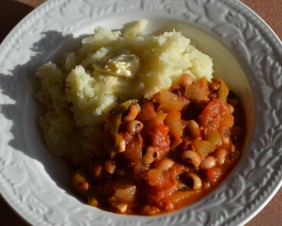Ah, comfort food. This is perfect breakfast food after a busy night. You can make it the day before, and feed 4 people with very little effort (and possibly a little toast) the next morning. It is warming and satisfying, but not at all heavy.
I designed this with sliced red potatoes (grated ones cooked to a mush), and with the tofu on top so it can bake and dry slightly. Don’t miss out on the lemon / lime juice that’s added to both the onion/pepper mix and the tofu; it gives an interesting zing, lifting the flavor and reducing the amount of salt required. The general consensus of opinion was that the vegan cheese was a good addition, too, and needed to be all over the surface, albeit in a thin layer. I baked it until both the cheese and the tofu were starting to brown.
2 tsp oil
1/4 large onion, cut into long strips
8 oz bell pepper flesh, diced or sliced
1/4 tsp lemon or lime juice
1/8 tsp salt
1 lbs red (waxy) potatoes, peeled and thinly sliced
1/4 tsp salt
1/8 tsp black pepper
1/2 cup cashew flour
14 oz firm tofu, drained
1 tsp salt
1/4 tsp black pepper
1 tbsp nutritional yeast
light dash of cayenne pepper
1 tsp Dijon mustard
1 tsp lemon/lime juice
6 baby tomatoes, for garnish
2 oz faux cheese, for garnish
Optionally serve with Ranchero sauce and toast.
Heat the oil in a large frying pan, and cook the onion and peppers over a medium heat, stirring occasionally, until softened, and the onions are starting to brown (~10 mins).
Line a 10 x 8″ casserole dish with parchment paper or grease. Peel and finely slice the potatoes into the casserole dish, and toss with the 1/4 tsp salt, and 1/8 tsp ground black pepper. Distribute evenly over the bottom of the casserole.
Sprinkle 1/4 lemon or lime juice and 1/8 tsp of salt over the onions and peppers, stir, then spread evenly over the potato.
Combine the remaining ingredients (except garnish), together in a large mixing bowl, and mash thoroughly with a pastry wire (or the back of a sturdy fork) until no large lumps remain, or pulse in a food processor, but do not puree.
Spread evenly over the onion and pepper layer.
Press the tomato and cheese garnish into the top of the tofu layer.
Bake in the middle of the oven, at 400F for 30-35 minutes.
Check the potatoes are completely cooked by sticking a fork into the middle of the dish, if still not soft, cook for another 10 minutes.
Serve warm rather than hot, optionally with Ranchero Sauce and almond bread.



































